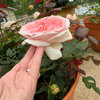Rose Rosette Confirmation?
wichitagardener
10 years ago
Related Stories

GARDENING GUIDESGreat Design Plant: Knock Out Roses
As glorious as their high-maintenance kin for a fraction of the work, Knock Out roses make even beginners look like garden stars
Full Story
GARDENING GUIDESWhat Kind of Roses Should You Grow?
Want to add the beauty of roses to your garden? Find out which ones, from old-fashioned to modern, are right for you
Full Story
GARDENING GUIDESLearn the Secret to Bigger and Better Roses
Grow beautiful roses using both ordinary and unusual soil amendments
Full Story
GARDENING GUIDES5 Sweet to Spirited Pink Roses for an Enchanting Garden
Whether you go demure or daring, there's a pink rose here to make you flush with garden pride
Full Story
GARDENING GUIDESRoses: Crowning Touch of Gardens
Whether you're the Miss or Mister America of gardening or take a hands-off approach, roses can be a winning addition to your landscape
Full Story
GARDENING GUIDESGreat Design Plant: Rosa Banksiae a Low-Maintenance Beauty
This thornless, disease- and insect-resistant rose brings showers of white or yellow flowers to the spring garden
Full Story
GARDENING GUIDESGreat Design Plant: Bugle Weed, a Quick Ground Cover
It’s highly adaptable, suppresses weeds, reduces erosion and provide weeks of bright flowers. Just watch for invasiveness
Full Story
HOUZZ TV FAVORITESHouzz TV: See How Early Settlers Lived in This Restored Pilgrim House
Passionate restoration and preservation efforts give a 1665 home an honored place in the present
Full Story












wichitagardenerOriginal Author
wichitagardenerOriginal Author
Related Professionals
Erie Landscape Architects & Landscape Designers · Marina Landscape Architects & Landscape Designers · Woburn Landscape Contractors · Caldwell Landscape Contractors · Cordele Landscape Contractors · East Haven Landscape Contractors · Fair Lawn Landscape Contractors · Holland Landscape Contractors · River Ridge Landscape Contractors · Tavares Landscape Contractors · Vancouver Landscape Contractors · Vashon Landscape Contractors · Waltham Landscape Contractors · Woodland Landscape Contractors · Irvington Landscape Contractorscatsrose
wichitagardenerOriginal Author
dublinbay z6 (KS)
Gosteelers70
michaelg
henry_kuska
wichitagardenerOriginal Author